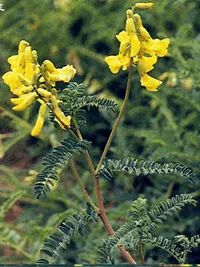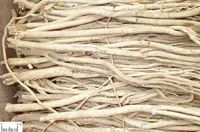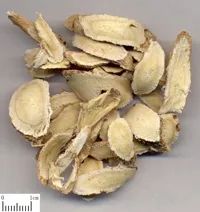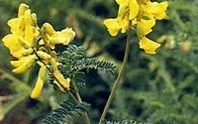Astragalus – Original State Astragalus – Medicinal Material
Astragalus – Medicinal Material
 Astragalus – Slices
Astragalus – Slices

It is the root of the leguminous plant Astragalus membranaceus (Fisch.) Bge. var. mongholicus (Bge.) Hsiao or Astragalus membranaceus (Fisch.) Bge. It is mainly produced in Inner Mongolia, Shanxi, Heilongjiang, and other regions. Harvested in spring and autumn, the roots are cleaned of fibrous roots and root tips, dried, sliced, and can be used raw or honey-fried. [Properties] Sweet, slightly warm. Enters the Spleen and Lung meridians. [Functions] Strengthens the Spleen and tonifies the center, raises Yang and lifts sinking Qi, benefits the Wei Qi and stabilizes the exterior, promotes urination, and expels toxins to generate flesh. [Applications] 1. Spleen Qi deficiency syndrome. This herb is sweet and warm, and is good at entering the Spleen and Stomach, making it a key herb for tonifying the center and benefiting Qi. For those with Spleen Qi deficiency, fatigue, low appetite, and loose stools, it can be used alone as a decoction or combined with Dang Shen (Codonopsis pilosula), Bai Zhu (Atractylodes macrocephala), and other Qi-tonifying herbs. Because it can raise Yang and lift sinking Qi, it is effective for treating Spleen deficiency with sinking Qi leading to chronic diarrhea and prolapse of the rectum, as well as organ prolapse. It is often used with Ren Shen (Panax ginseng), Sheng Ma (Cimicifuga foetida), and Chai Hu (Bupleurum chinense), such as in the formula Bu Zhong Yi Qi Tang (《脾胃论》). If Spleen deficiency leads to water retention and edema, this herb can both tonify the Spleen and Qi, and promote urination and reduce swelling, making it a key herb for treating Qi deficiency with edema, often combined with Bai Zhu and Fu Ling (Poria cocos). This herb also tonifies Qi and generates blood, and is often used with blood-tonifying herbs, such as in the Dang Gui Bu Xue Tang (《兰室秘藏》). For bleeding due to Spleen deficiency unable to control blood, this herb can tonify Qi to restrain blood, often used with Ren Shen and Bai Zhu, such as in the Gui Pi Tang (《济生方》). For thirst due to Spleen deficiency unable to distribute fluids, this herb can tonify Qi and generate fluids, promoting the generation and distribution of body fluids to alleviate thirst, often used with Tian Hua Fen (Trichosanthes kirilowii) and Ge Gen (Pueraria lobata), such as in the Yu Ye Tang (《医学衷中参西录》). 2. Lung Qi deficiency syndrome. This herb enters the Lung and can tonify Lung Qi, useful for those with weak Lung Qi, chronic cough and wheezing, shortness of breath, and fatigue, often combined with Zi Wan (Aster tataricus), Kuan Dong Hua (Tussilago farfara), and Xing Ren (Prunus armeniaca) for phlegm resolution and cough relief. 3. Qi deficiency with spontaneous sweating. Individuals with Spleen and Lung Qi deficiency often have weak Wei Qi, leading to spontaneous sweating. This herb can tonify Spleen and Lung Qi, benefiting Wei Qi and stabilizing the exterior, often used with Mu Li (Oyster Shell) and Ma Huang Gen (Ephedra) for stopping sweating, such as in the Mu Li San (《和剂局》). If spontaneous sweating due to weak Wei Qi makes one susceptible to wind pathogens, it is advisable to use it with Bai Zhu and Fang Feng (Saposhnikovia divaricata), such as in the Yu Ping Feng San (《丹溪心法》). 4. Qi and blood deficiency, difficult-to-heal sores and ulcers. This herb, with its Qi tonifying properties, can also expel toxins and generate flesh. In the mid-stage of sores, when the Zheng Qi is weak and toxins are strong, making it difficult for the toxins to be expelled, the sores appear flat and diffuse, difficult to heal, this herb can be used to tonify Qi and generate blood, supporting Zheng Qi and expelling pus and toxins, often combined with Ren Shen, Dang Gui, Sheng Ma, and Bai Zhi (Angelica dahurica), such as in the Tuo Li Tou Nong San (《医宗金鉴》). In the late stage of ulcers, due to Qi and blood deficiency, with clear and thin pus, and difficulty in healing the sore, this herb can tonify Qi and generate blood, promoting flesh growth and healing, often combined with Ren Shen, Dang Gui, and Rou Gui (Cinnamon), such as in the Shi Quan Da Bu Tang (《和剂局方》). Additionally, for Bi syndrome and sequelae of stroke due to Qi deficiency leading to blood stagnation, presenting with numbness of the skin or hemiplegia, this herb is also commonly used to tonify Qi to promote blood circulation. For treating wind-cold-damp Bi syndrome, it is advisable to combine it with Chuan Wu (Aconitum carmichaelii), Du Huo (Angelica pubescens), and other wind-damp dispelling herbs, and with Chuan Xiong (Ligusticum chuanxiong) and Niu Xi (Achyranthes bidentata) for invigorating blood. For sequelae of stroke, it is often used with Dang Gui, Chuan Xiong, and Di Long (Lumbricus), such as in the Bu Yang Huan Wu Tang (《医林改错》). [Dosage] Decoction, 9-30g. Honey-frying can enhance its Qi tonifying effects. [Differentiation with other herbs] Ren Shen, Dang Shen, and Huang Qi all have the effects of tonifying Qi, generating fluids, and generating blood, and are often used together to enhance each other’s efficacy. However, Ren Shen is stronger and is known as the premier Qi tonifying herb, with effects of rescuing from collapse, calming the mind, enhancing intelligence, and assisting Yang. Dang Shen has a milder Qi tonifying effect, focusing on benefiting the Qi of the Spleen and Lung, and can also tonify blood. Huang Qi, while not as strong in tonifying original Qi as Ren Shen, excels in raising Yang, benefiting Wei Qi, expelling pus and generating flesh, and promoting urination and reducing swelling, especially suitable for Spleen deficiency with sinking Qi and spontaneous sweating due to exterior deficiency. [Classical Text Excerpts] 1. From the Shen Nong Ben Cao Jing: “Treats carbuncles, chronic ulcers, expels pus and alleviates pain… tonifies deficiency.” 2. From the Ben Cao Hui Yan: “Tonifies the Lung, strengthens the Spleen, solidifies Wei Qi, stops sweating, dispels wind and moves toxins.” 3. From the Yi Xue Zhong Zhong Can Xi Lu: “Can tonify Qi, also can raise Qi, good for treating the sinking of the great Qi in the chest (i.e., the Zong Qi…).” [Modern Research] 1. Chemical components: This herb mainly contains saponins, polysaccharides, flavonoids, amino acids, and trace elements. 2. Pharmacological effects: Huang Qi can promote metabolism, combat fatigue, promote the renewal of serum and liver proteins; it has significant diuretic effects, can eliminate urinary protein in experimental nephritis; it can improve anemia in animals; it can raise low blood sugar and lower high blood sugar; it can stimulate respiration; it can enhance and regulate immune function, promoting the interferon system and improving the body’s resistance to disease; it has mild inhibitory effects on cell damage caused by various viruses, and protective effects against influenza virus infection in mice; it has a broad antibacterial effect; in cell culture, it can significantly increase cell numbers, promote vigorous cell growth, and extend cell lifespan; it can enhance myocardial contractility, protect the cardiovascular system, combat arrhythmias, dilate coronary and peripheral blood vessels, lower blood pressure, reduce platelet aggregation, and decrease thrombus formation; it also has lipid-lowering, anti-aging, anti-hypoxia, anti-radiation, and liver-protective effects. 3. Clinical studies: Reports indicate that decocting 50g of Huang Qi daily for treating allergic rhinitis, chronic rhinitis, and preventing upper respiratory infections in children has shown excellent results (Chinese Medicine Journal, 2000, 6:331); taking 2ml of Huang Qi extract daily (equivalent to 2g of raw herb) for preventing upper respiratory infections in 100 children showed a 94% effective rate (Harbin Medical University Journal, 1993, 5:366); using Huang Qi to treat 92 cases of ischemic heart disease showed better relief of angina, improved electrocardiograms, and heart impedance graphs compared to Xintong Ding and Danshen (Chinese Journal of Immunology, 1989, 2:119-120). This herb is also used for treating pediatric asthma, coronary heart disease, arthritis, ischemic cerebrovascular disease, chronic nephritis, chronic hepatitis, postpartum non-infectious fever, and allergic rhinitis. 4. Adverse reactions: Reports of Huang Qi injection causing rashes and allergic shock; in 12 pregnant women over 7 months, continuous use of Huang Qi for 15 days, totaling over 300g, resulted in 8 overdue pregnancies, prolonged labor in 6 cases, delayed placental separation in 3 cases, episiotomy in 4 cases, forceps delivery in 1 case, and cesarean section for 1 case due to fetal macrosomia, with fetal weights ranging from 3500g to 4600g.

